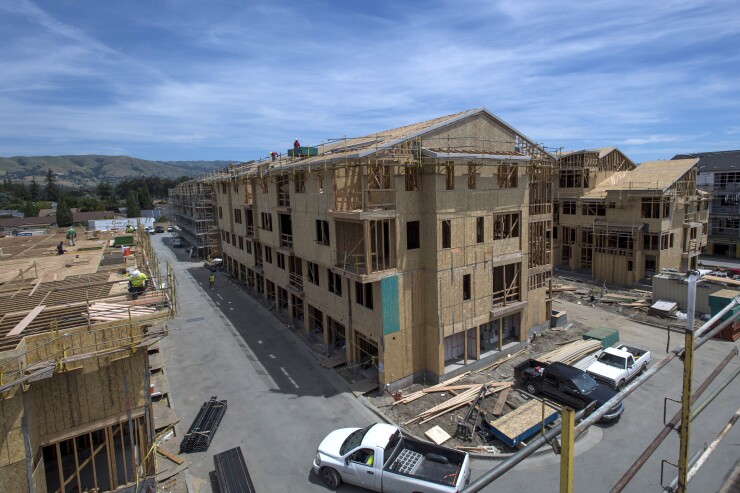The latest economic data released Thursday continues to show an economy battered and bruised by the effects of the COVID-19 pandemic.
Since the start of the coronavirus pandemic, about 26.5 million Americans have lost their jobs, according to WalletHub, completely wiping out the 22.7 million new jobs created since the Great Recession.
Sales of new single‐family houses fell 15.4% in March, the Commerce Department reported while the Labor Department said initial jobless claims fell to 4.427 million in the latest week.
Claims were down 810,000 in the week ended April 18 from the prior week's revised level of 5.237 million, originally reported as 5.245 million.
However, there likely will be more pain ahead.
“Massive job losses are still expected over the coming weeks as more people become furloughed and as backlogs clear,” said Edward Moya, senior market analyst at OANDA. “The unemployment rate seems poised to hit the 20% level and this alone should be reason enough for the Fed and Trump administration to keep throwing stimulus into the economy.”

The four-week moving average rose 280,000 to 5,786,500 from the previous week's revised average of 5.507 million, originally reported as 5.509 million.
The advance seasonally adjusted insured unemployment rate was 11.0% for the week ending April 11, a gain of 2.8 percentage points from the previous week's unrevised rate. This was the highest level for the rate in the history of the seasonally adjusted series.
The advance number for seasonally adjusted insured unemployment during the week ending April 11 was 15.976 million, the highest level in the history of the series.
The total number of people claiming benefits in all programs for the week ending April 4 was 12.507 million. In the comparable week last year, there were 1.758 million persons claiming benefits in all programs.
While Thursday’s data shows another week of a decline, it was still among the highest levels in U.S. history, according to the Tax Foundation.
“Approximately 12.5% of the U.S. civilian labor force has now applied for or is receiving unemployment compensation benefits (through April 18, the latest data). The previous high was 7.9% early in 1975 during a recession, with a Great Recession peak of 4.8% between February and April 2009,” Jared Walczak and Tom VanAntwerp of the Tax Foundation wrote in a Thursday comment.
The largest increases in initial claims for the week ending April 11 were in Colorado (+58,246), New York (+50,250), Missouri (+10,668), Florida (+10,534), and North Carolina (+2,733), while the largest decreases were in California (-263,342), Michigan (-166,347), New Jersey (-73,416), Georgia (-70,551), and Ohio (-66,874).
According to
Sales of new single‐family houses fell in March to a seasonally adjusted annual rate of 627,000 from a revised 741,000 rate in February, originally reported as 765,000.
March’s level is 9.5% below the March 2019 rate of 693,000.

The median sales price of new houses sold in March 2020 was $321,400. The average sales price was $375,300.
The seasonally adjusted estimate of new houses for sale at the end of March was 333,000. This represents a supply of 6.4 months at the current sales rate.
"All regions of the country saw declines in sales as mandatory stay-at-home orders started to come down in the middle of March. This month’s data is a preview of what is to come for the rest of the quarter," said Yelena Maleyev, associate economist at GrantThornton. "As the historically busy home-buying season is starting, the COVID-19 pandemic threatens people’s health and jobs, so purchase decisions will come to a near standstill."
Commerce also revised the March number of building permits downward to show a 7.0% drop in March to a 1.350 million rate from the originally reported 6.8% decline to a 1.353 million rate.
The Federal Reserve Bank of Kansas City’s April manufacturing survey showed that activity further decreased to the lowest reading in survey history, while expectations for future activity improved but remained slightly negative.
“Regional factory activity continued to decline in April, with our composite index falling to the lowest level in survey history [1994] as firms continued to be negatively impacted by COVID-19,” said Chad Wilkerson, vice president at the Kansas City Fed. “Many firms also reported employment changes in response to coronavirus.”
The month-over-month composite index fell to negative 30 in April, down from negative 17 in March and 5 in February. All month-over-month indexes dropped in April except for supplier delivery time, which continued to increase.
The future composite index improved from negative 19 April, but remained in the red at negative 6.





